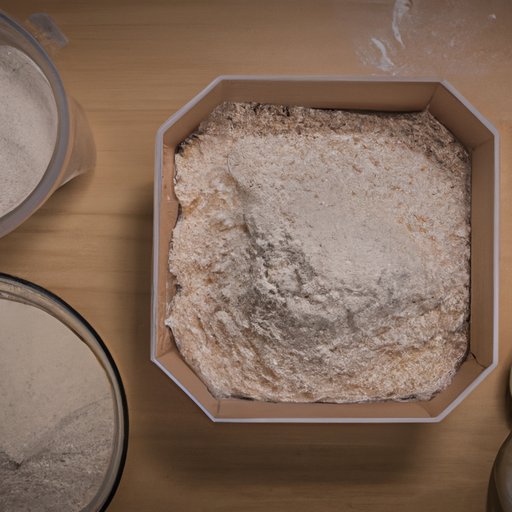
I. Introduction
Bread flour is the ultimate ingredient for making delicious, crusty bread at home. Unlike all-purpose flour, bread flour has higher protein content, which results in a chewy and flavorful bread. However, store-bought bread flour can be expensive, and not all grocery stores carry it.
Luckily, making bread flour at home is both easy and cost-effective! In this guide, we will cover everything you need to know about making bread flour from scratch, including step-by-step instructions, troubleshooting tips, and variations.
II. Step-by-Step Guide
1. Gather the ingredients. To make bread flour, you will need all-purpose flour and vital wheat gluten. The ratio is 1 tablespoon of vital wheat gluten per 1 cup of flour.
2. Sift the flour. Start by sifting your all-purpose flour to remove any lumps. You can use a sifter or a fine-mesh strainer for this step.
3. Add vital wheat gluten. Measure out one tablespoon of vital wheat gluten for every cup of flour and add it to the sifted flour. Use a whisk or fork to combine the two ingredients.
4. Mix well. Transfer the mixture to a large bowl and mix the ingredients well. Make sure to combine them evenly, so that the vital wheat gluten is distributed throughout the flour.
5. Store the bread flour. Once mixed, your bread flour is ready to use! You can store it in an airtight container for up to six months.
Tips: When baking with bread flour, it’s essential to measure accurately. Use a kitchen scale to measure your ingredients or use measuring cups and spoons. Remember that each brand of flour can have a different protein content, so start by using a small amount of flour until you find the right consistency for your recipe.
Troubleshooting: If your bread turns out too dense or tough, you may have added too much vital wheat gluten. Decrease the amount of vital wheat gluten in the next batch. Alternatively, if your bread is too crumbly or falls apart, you may not have added enough vital wheat gluten. Increase the amount of vital wheat gluten in the next batch.
III. Beginner’s Guide
If you’re new to baking or want a simplified version of the step-by-step guide, don’t worry! Making bread flour at home is easy, and we’ve got you covered.
1. Start with all-purpose flour. You can use any brand of all-purpose flour for this recipe.
2. Add vital wheat gluten. Measure out one tablespoon of vital wheat gluten for every cup of flour and add it to the all-purpose flour.
3. Mix well. Mix the ingredients well using a whisk or fork.
Tips: If you want to learn more about technical cooking terms used in this recipe, check out our baking glossary. You can also follow visual aids, such as videos or guides.
IV. Variations of Bread Flour
While all-purpose flour may be the most common ingredient to use when making bread flour, other types of flour can be used as well. Here are a few variations to try:
Whole Wheat Bread Flour
To make whole wheat bread flour, mix 1 cup of whole wheat flour with 1 tablespoon of vital wheat gluten.
Rye Bread Flour
To make rye bread flour, mix 1 cup of rye flour with 1 tablespoon of vital wheat gluten.
Spelt Bread Flour
To make spelt bread flour, mix 1 cup of spelt flour with 1 tablespoon of vital wheat gluten.
Tips: When using different types of flour, keep in mind that the protein content varies. Adjust the amount of vital wheat gluten accordingly.
V. The Science Behind Bread Flour
To understand why bread flour is so important in baking, it’s helpful to know a bit about the science behind it. The key ingredient in bread flour is vital wheat gluten, a protein that gives bread its structure and chewiness. Without it, bread would be dense and flat. The higher protein content of bread flour results in a higher gluten content, which creates a stronger, more elastic dough. The other ingredients in bread flour – water, sugar, salt, and yeast – all work together to create a flavorful, crusty bread.
VI. Common Conversions
If you don’t have vital wheat gluten on hand, you can still make bread flour using all-purpose flour. Here’s how:
1. Start with all-purpose flour. Measure out the amount you need for your recipe.
2. Remove some flour. For every cup of all-purpose flour, remove two tablespoons of flour.
3. Add vital wheat gluten. Replace the two tablespoons of flour with 2 teaspoons of vital wheat gluten.
4. Mix well. Mix the ingredients well using a whisk or fork.
Tips: While this method can work in a pinch, it may not produce the same results as using pure bread flour. Experiment with different ratios until you find the right consistency for your recipe.
VII. Conclusion
Now that you know how to make bread flour from scratch, there’s no need to spend money on expensive store-bought flour. With a few simple ingredients and some basic knowledge, you can create delicious, crusty bread at home. Remember to measure accurately, experiment with different types of flour, and enjoy the process.




